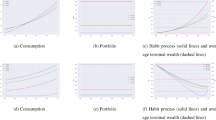Abstract
An oligopolistic market in which several firms supply a homogeneous product is considered. One particular firm (leader) sets its decision prior to the other firms (followers), which react by playing a competition in quantities. The aim of the paper is to investigate the existence of suitable strategies for the leader in the presence of aggregative coupled constraints in the case in which (i) the aggregate quantity reaction Q is single-valued and (ii) the aggregate quantity reaction Q is set-valued and the leader has some probabilistic information on the followers choice in their reaction set.
Similar content being viewed by others
References
C.G. Reid (1981) The Kinked Demand Curve Analysis of Oligopoly Edinburgh Universisty Press Edinburgh
KJ Lancaster (1996) ArticleTitleA New Approach to Consumer Theory Journal of Political Economy. 74 132–157
M. Shubik (1959) Strategy and Market Structure Wiley New York
C.G. Reid (1977) ArticleTitleDiscontinuity Problems in a Generalized Price Leadership Model Journal of Economic Studies. 4 38–44
J. Roberts H. Sonnenschein (1976) ArticleTitleOn the Existence of Cournot Equilibrium without Concave Profit Functions Journal of Economic Theory. 13 112–117
S. Flam L. Mallozzi J. Morgan (2002) ArticleTitleA New Look on Stackelberg Cournot Equilibria in Oligopolistic Markets Economic Theory. 20 183–188
. Carlson D.A A. Haurie (1999) ArticleTitleInfinite-Horizon Dynamic Games with Coupled State Constraints Annals of the International Society of Dynamic Games. 5 195–212
Krawczyk J. (2000). An Open-Loop Nash Equilibrium in an Environmental Game with Coupled Constraints , Proceedings of the 9th International Symposium on Dynamic Games and Applications, Adelaide, South Australia, Australia, 2000
L. Corchon (1994) ArticleTitleComparative Statics for Aggregative Games: The Strong Concavity Case Mathematical Social Science. 28 151–165
G. Debreu (1952) ArticleTitleA Social Equilibrium Existence Theorem Proceedings of the National Academy of Sciences, USA. 38 886–893
J.B. Rosen (1965) ArticleTitleExistence and Uniqueness of Equilibrium Points for Concave n-Person Games Econometrica. 33 520–534
P.T. Harker J.S. Pang (1990) ArticleTitleFinite-Dimensional Variational Inequality and Nonlinear Complementarity Problems: A Survey of Theory Algorithms, and Applications, Mathematical Programming. 48 161–220
H.D. Sheraly A.L. Soyster F.H. Murphy (1983) ArticleTitleStackelberg-Nash-Cournot Equilibria: Characterizations and Computations Operation Research. 31 253–276
F.H. Murphy H.D. Sheraly A.L. Soyster (1982) ArticleTitleA Mathematical Programming Approach for Determining Oligopolistic Market Equilibrium Mathematical Programming. 24 92–106
D. Monderer L.S. Shapley (1996) ArticleTitlePontential Games Games and Economic Behavior. 14 124–143
J.P. Aubin H. Frankowska (1990) Set-Valued Analysis Birkhauser Boston
E. Kleine A.C. Thompson (1984) Theory of Correspondences Wiley New York
T. Basar G.J. Olsder (1995) Dynamic Noncooperative Game Theory Academic Press New York
M. Osborne A. Rubinstein (1990) Bargaining and Markets Academic Press New York
E. Van Damme (1991) Stability and Perfection of Nash Equilibria Springer Verlag Berlin
Morgan J. Constrained Well-Posed Two-Level Optimization Problems , Nonsmooth Optimization and Related Topics, Edited by F. H. Clarke, V. F. Demyanov , and F. Giannessi, Plenum Press, New York, NY, 1989
Lignola, M. B ., and Morgan, J ., Existence for Optimization Problems with Equilibrium Constraints in Reflexive Banach Spaces , Optimization in Economics, Finance, and Industry, Edited by G. P. Crispi, G. Giorgi, A. Guerraggio, D.La Torre, E. Miglierina, and M. Rocca, Datanova, Milano, Italy, pp. 15–35, 2002.
Mallozzi L., Morgan J. (1995). Problema di Stackelberg con Risposte Pesate. Atti del XIX Convegno della Associazione per la Matematica. Applicata alle Scienze Economiche e Sociali. 416–425
M. Breton A. Alj A. Haurie (1980) ArticleTitleSequential Stackelberg Equilibria in Two-Person Games Journal of Optimization Theory and Applications. 59 71–97
G. Leitmann (1978) ArticleTitleOn Generalized Stackelberg Strategies Journal of Optimization Theory and Applications. 26 637–643
R.B. Ash (1972) Real Analysis and Probability Academic Press New York
Author information
Authors and Affiliations
Rights and permissions
About this article
Cite this article
Mallozzi, L., Morgan, J. Oligopolistic Markets with Leadership and Demand Functions Possibly Discontinuous. J Optim Theory Appl 125, 393–407 (2005). https://doi.org/10.1007/s10957-004-1856-6
Issue Date:
DOI: https://doi.org/10.1007/s10957-004-1856-6




